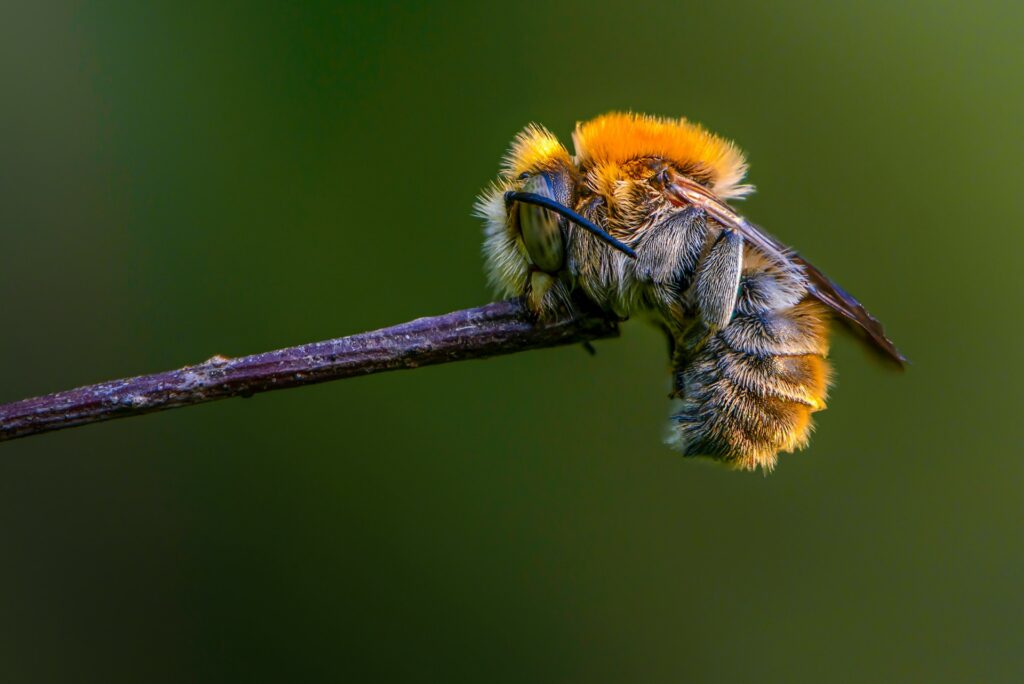The Buzz About Bee Sleep

Whether you know it or not, bees sleep. The resting position of bees is quite endearing as they lower their heads and rest their wings on their backs. Bees’ relentless work habits and dedication to their queen often make it seem unreasonable that sleep is on the day’s agenda. However, these little pollinators tire of collecting nectar, building, making honey, and protecting their queen – being a bee is hard work, and rest is required!
It is not often that people observe bees in the resting state. Whether napping or taking a slumber, bees have a relaxed posture, and their temperatures lower, which means they will not respond quickly to disturbances. Research shows that bees’ neuronal activity during sleep is similar to humans in that the response time depends on the sleep phase – fascinating! What is more intriguing is that bees lower their heads in a bowing gesture, drop their antennae, and rest their wings on their little bodies. Bees not only sleep in the beehive but they can be found sleeping on flowers, and even a wall!
Bee Sleep Patterns
Although research shows that bees have relaxed and light and deeper sleep states, unlike humans, bees do not follow a specific rhythm, like sleeping during the day or night. The bees’ role and age play a significant part in when they choose to rest. Forager bees are older (when a bee reaches more than 21 days old, they are considered elderly) and are moved to out-of-colony tasks, including collection of water, resin, and nectar. Forager bees do not have the energy to go full throttle like the worker bees. Worker bees only require short naps to get through their days, while forager bees rest away from the hustle and bustle of the hive’s activity center. Wherever bees end up taking their rest, they put safety first. Bees who end up sleeping on plants and flowers clamp their mandibles onto the plant so they are not blown off. Although they may appear to be floating, they are not – they are safe and secure in place.
Bee naps and slumbers can be for a few minutes or several hours and can be in the middle of a flower or right on the edge. Females typically sleep inside the nest, whereas male bees are more likely to be found sleeping outside. Honeybees have been regularly documented to sleep 5-8 hours a day!
Why Do Bees Sleep?
Beyond being tired from all their busy work, bees also use rest for other reasons. One reason is to help with memory. Studies have been done that were Pavlovian in nature, and bees that fell into deeper sleep states recalled relationships between food and certain odors better than those that did not. As with humans, bees communicate; the rest allows them to consolidate and solidify the information they acquire from other bees. Another reason bees need sleep is to be able to perform their jobs well. The waggle dance, which is well known to direct bees to food, pollen, and nectar sources, must be done efficiently. A bad waggle dance can waste the bees’ energy as they search and search and may even be directed in the wrong direction. Lastly, bees need sleep to be able to quickly learn new routes back to the hive when danger is present. Lacking memory of where home is can make it challenging for a bee to get home safely after being directed to a new food or pollen source. Denying bees sleep will lead to fatigue, which leads to poorer performance of duties and potentially hazardous to their health.
So, if you walk up to a beautiful flower, ready to take a giant sniff and encounter a tucked-up little bee, let it rest. Bees are hard-working and deserve to be left undisturbed unless they are causing an immediate threat to people. Even if you are not a fan of bees, seeing them sweetly tucked into themselves is a sweet moment. Although bees do slumber, even heavily at times, when disturbed, they slowly wake and move away. Learning more about bees is critical to having a greater understanding and appreciation for these vital pollinators. Bees are the only pollinators that play a role in actually producing edible food for humans – that delicious honey!
Contact your local beekeeper today if you want to learn more or are craving some delicious, ooey, gooey local honey to include in your Thanksgiving meal dishes. If you are in San Diego County, D-Tek offers excellent resources for those wanting local honey or having questions about bees in their area. If you have a beehive in a location that may pose a threat to you and your family, please contact D-Tek for help humanely removing and relocating live bees. It is vital to honor the contributions of these little bees that aren’t that much different than humans when it comes to needing our rest!
